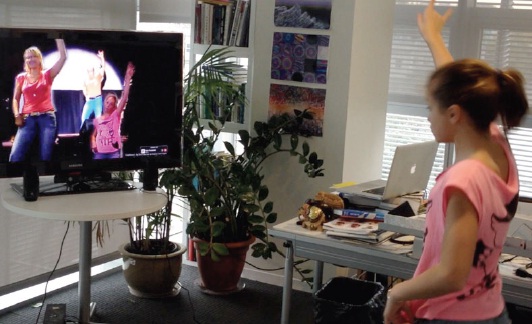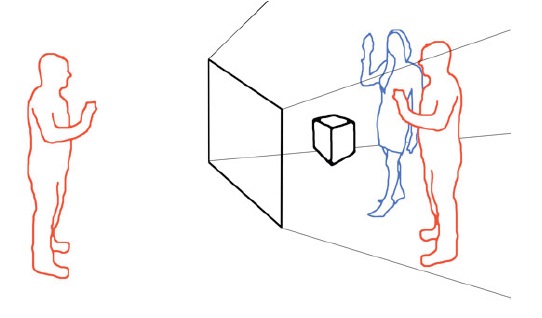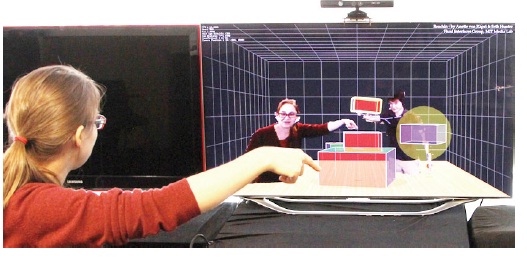





Published on Jan 09, 2026
TeleKinect is a platform for collaborate interactions at a distance in the same virtual space. The framework supports the real-time videos transport of foreground elements from remote locations and composites them into a merged virtual space. In this position paper we present two applications that utilize the framework for shared experiences at a distance: WaaZam is an application focused on supporting social engagement through creative play.
It is focused on how users can collaboratively customize the environment and build sets and studios as places to be together at a distance. The project presents potential scenarios where users can do things together like broadcasting, karaoke, presentations, teaching, and watching television. InReach explores how remote collaborates can "reach into" a shared digital workspace where they can manipulate virtual objects and 3D data. The demo presents scenarios where users can manipulate simple 3D data for discussion, visualization, and online education environments for classroom purposes
In times of globalization, colleagues, collaborators and families are often distributed all over the world. An ordinary day often involves collaborations for which at least one person is in a remote location. With the increasing availability and decreasing cost of Internet bandwidth, video cameras, computers, and microphones, the barriers to designing more effective remote collaboration systems have been lowered. However, several problems persist in state of the art technology used for remote collaboration. These include visually disjunctive physical and virtual spaces, limited ways to employ gestures as a communication tool, and limited ways to collaboratively refer to and manipulate shared content. It is useful to distinguish two types of remote experiences.

The first type is a meeting that focuses on critical decisionmaking, while the second type is a shared experience that focuses on the collaborative creation and modification of digital content. In a decision-making session, collaborators might prefer to have a sense of being in the same room as if they were talking face-to-face thereby concentrating on the interpersonal space.
In such a context, the attention lies on displaying a realistic representation of the remote person on the screen, correct as to their physical size and gaze direction, and extending the remote physical space into the local place. In contrast, a second type of session includes creative meetings that are more directed towards brainstorming as well as sessions that are about a shared activity or exploration. In these encounters the focus is on the data itself, the shared space.
Our families, colleagues and friends are progressively more geographically separated. Although possible with current technologies, there are very few communication platforms that facilitate synchronous creative interaction at a distance. Current video communication systems are not designed well to support co-creative activities at a distance and creative telepresence systems have been under-explored in research literature, particularly in the context of bodily activities such as theatre and dance that require participants to coordinate directly with each other. WaaZam is a telepresence platform that focuses on supporting creative collaboration in a composited video environment that incorporates depth analysis, object tracking, and gestural interaction. Unlike current telepresence environments, WaaZam gives users more creative control over their experiences by facilitating the creation and customization of the space during a live session.

For decades artists and technologists have developed strategies to help users relate to interactive content. Notable examples are Myron Krueger’s early experiments in artificial reality and David Rokeby’ transforming mirrors. In the research domain composited video environments such as Agamanolis’ Reflexion, Markopoulos’ PhotoMirror and the HyperMirror project have been developed to merge distant spaces on one screen. Our application extends this work by focusing on identifying the tools and scenarios that will best facilitate social engagement through creative play between parents and children and supporting collaborative customization of the environment together.
We are interested in the integration of the interpersonal space and the shared workspace in one and the same experience. With InReach (Figure 3) collaborators see their live 3D recreated mesh next to each other in a shared virtual space on a large screen in front of them, which creates the illusion of an augmented mirror (Figure 4). In this mirror you can see yourself as well as your collaborator inside the models and information which you are collaborating on. It breaks down the virtual curtain that separates collaborators in a face-to-face setting. Collaborators can point at data or 3D models. They can grab digital objects with their bare hands, translate, scale, and rotate them. For this we distinguish one-handed and bimanual actions. All of these interactions are illustrated in contrast with the traditional view for remote conferencing

InReach is particularly useful for situations in which users use their body to point to and manipulate the data, and can see themselves in relation to the data. Notable prior work in this area include ClearBoard [4], a system, which allows two remote users to collaboratively draw on a shared virtual surface. The office of the future [9] concept describes how we could collaboratively manipulate virtual, 3D objects from our office desks extending the real office with projected images of a remote office and virtual objects. MirageTable [1] mimics the situation of two collaborators working at a table.
Users can create virtual copies of real objects. A digital representation of each user’s hands can interact with virtual objects in a physical simulation. ARCADE [10] allows remote video-based presentation. Virtual 3D objects can be placed on top of the video of the remote collaborator who can directly manipulate them with his hands.

We are encouraged by the initial feedback from users of both applications and are working to upgrade to more precise hardware, improve and evaluate gestural capabilities, simulate more realistic physics interactions, and study our system in a variety of contexts. In future work, WaaZam will provide case studies of specific user experiences that describe challenges associated with creative coordination at a distance. The researchers are studying how to support and encourage storytelling, pretend-play, and improvisation between parents and children in divorced families and families with one traveling parent.
We are conducting a user study to determine the effectiveness of the customization features and assess the potential of these environments to support social engagement through creative play and shared activities. For InReach our long-term goal is to study how our system can be integrated in industries that use 3D models extensively in their design processes. These include fields such as architectural, interior, and landscape design; applications where the collaboration revolves around the body, such as theater and dance; and joint presentations that would benefit from a shared virtual space for two and more remote collaborators.
1. Benko, H., Jota, R., and Wilson, A. MirageTable: freehand interaction on a projected augmented reality tabletop In Proc. CHI 2012, 199-208.Anderson, R.E. Social impacts of computing: Codes of professional ethics. Social Science Computing Review 10, 2 (1992), 453-469.
2. Cullinan, C. and Agamanolis, S. Reflexion: a responsive virtual mirror. Conference Companion, UIST 2002. Klemmer, R.S., Thomsen, M., Phelps-Goodman, E.,
3. Krueger, Myron: Artificial Reality, Addison-Westly, 1991.
4. Hiroshi Ishii, Minoru Kobayashi, and Kazuho Arita. 1994. Iterative design of seamless collaboration media. Commun. ACM 37, 83-97.
| Are you interested in this topic.Then mail to us immediately to get the full report.
email :- contactv2@gmail.com |